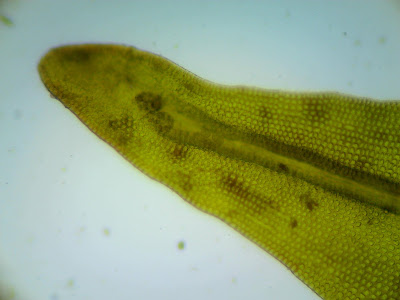Foel Drygarn
I went looking for Sam's small patch of Kiaeria blytti on the old hill-fort at Foel Drygarn, but mis-interpreted the location and found a new sub-population instead. There was a healthy population under a few rocks on the eastern cairn - at least 20 small tufts in one place, several with young fruits and a few old capsules as well.
Confusion reigned when I tried to confirm it using the key in Smith, as the basal cells on some shoot seemed too thick-walled and porose, the alar cells well-differentiated, and the old capsules were striate. The nerve sections also seemed to be a closer match for one of the rare Scottish species, starkei or glacialis.
Kiaeria
Thankfully, Tom pointed out that either species would be desperately unlikely, and I eventually located a Czech key by Jan Kucera which seemed more authoritative than those in Smith or the Flora of North America. Transverse sections of the alar cells are needed, and these are unistratose in blytti and partially bistratose and bistratose in starkei and glacialis respectively. Mine, unfortunately, were unistratose and order was restored....more lessons learned!



















